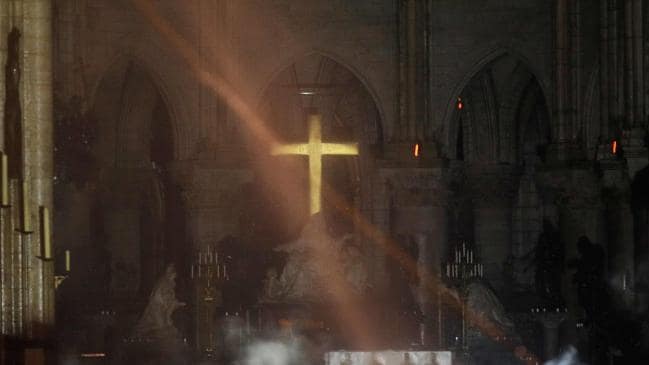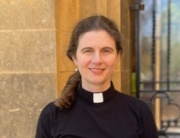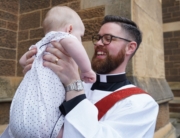
John 20.1-18
The Rev’d Canon Jenny Wilson
In the name of God, creating, redeeming, sanctifying, … Amen.
Was it watching Notre Dame burn? Was that the closest that death and destruction and the truth of the utter vulnerability of our life came to us in recent days?
Flames and smoke rose from the blaze at Notre Dame Cathedral in Paris that night. The Cathedral was within “15 to 30 minutes” of complete destruction as firefighters battled to stop flames reaching its gothic bell towers, French authorities revealed.
Was it watching Notre Dame burn? Was it when the spire fell almost in slow motion to the gasps and cries of Parisians who found in this building some sense of hope, of meaning, of identity? Was it watching Notre Dame burn? That our vulnerability struck us?
Or was it listening to the sixteen year old Swedish climate activist Greta Thunberg addressing the European Union Council about the desperate state of our planet? As she spoke of a “sixth mass extinction” her voice faltered. “The extinction rate is up to six times faster than what is considered normal, with up to 200 species becoming extinct every single day,” she said. “Erosion of fertile topsoil, deforestation of the rainforest, toxic air pollution, loss of insects and wildlife, acidification of our oceans – these are all disastrous trends. … It is still not too late to act. It will take a far-reaching vision, it will take courage, it will take fierce, fierce determination to act now, to lay the foundations where we may not know all the details about how to shape the ceiling,” she said. “In other words it will take cathedral thinking. I ask you to please wake up and make changes required possible.”[1]
Is it when we contemplate our deep concern for our planet that we find ourselves remembering those women walking to the tomb? To Jesus’ tomb.
Or have we known our own deaths in recent days? Have we sat beside the coffins of our own loved ones and known the utter loneliness that comes from the truth that we will not talk with them anymore, drink a cup of tea with them anymore, be irritated by them anymore, love their very presence any more. Here in our cathedral community we have lost several people dear to us in recent weeks and we know that biting loneliness, that fierce truth. The truth that death is.
We cannot hear this story of Jesus’ empty tomb and what happened there, we cannot hear this story unless we have sat by the tombs of defeat and loneliness, known what it is to be a human being that loses what we love and hold dear. This is the place where our gospel story belongs.
He was their hope, their meaning, their identity. And on Good Friday, Golgotha hurled death at him. Jesus’ death was bitter and cruel, a place of torture and mockery, of desertion and betrayal. And he, even knowing the despair of his Father God’s absence in it, had loved and forgiven, with a forgiveness that sent shock waves through creation. “Father, forgive them,” he said looking at the ones who had nailed him to his cross, “for they do not know what they are doing.” And then as he died he still trusted God. “Father, into your hands I commit my spirit.” He said as he breathed his final breath. Jesus inhabited death, all the fear and pain of it, all the senselessness of it, for us.
They wrapped his body in linen cloths and placed him in a tomb.
Early on the first day of the week, while it is still dark, Mary Magdalene comes to the tomb and sees that the stone has been removed from the tomb. So she runs and goes to Simon Peter and the other disciple, the one whom Jesus loved, and says to them, ‘They have taken the Lord out of the tomb, and we do not know where they have laid him.’ (John 20:1-2)
Mary Magdalene has come to Jesus’ tomb to spend a little more time with him with the truth of his death. But the tomb is empty. The linen cloths are lying there, …folded, …but Jesus is gone. Simon Peter and the other disciple run to the tomb when Mary has told them what she has seen and they look inside. It is the other disciple who this story says “sees and believes.” Sees and believes that life has emerged here, that Jesus has risen from the dead, as he said he would.
So far all we have is a lack of him, a lack of death, and the faith of this disciple but Mary stays weeping.
As she weeps, she bends over to look into the tomb; and she sees two angels in white, who ask her why she is weeping. She says to them, ‘They have taken away my Lord, and I do not know where they have laid him.’ When she has said this, she turns round and sees Jesus standing there, but she does not know that it is Jesus. How is it possible that she doesn’t know him? How could she not know him? Jesus says to her, ‘Woman, why are you weeping? For whom are you looking?’ Supposing him to be the gardener, she says to him, ‘Sir, if you have carried him away, tell me where you have laid him, and I will take him away.’ Jesus says to her, ‘Mary!’ (John 20:11-16)
Twice, she is asked why she is weeping. It is as if the ones who know God’s way of things, the angels, Jesus himself, know that tears have no place here. A tomb where tears absolutely have a place has been transformed. “Woman, why are you weeping?” Mary assumes the one speaking to her is a gardener and that the body, the evidence that this is still a place of death, has just been placed somewhere else. It is when Jesus speaks her name that she knows him. “Mary,” he says. The one who gave her hope and healing, identity and meaning is restored to her in the speaking of her name. Their relationship is restored.
God’s life has broken in here. This is an extraordinary truth, this truth of resurrection. It is not some sweet story. It is a wild and utterly unexpected truth. That this faithful man who endured this awful death has been vindicated by God. Your will be done, Jesus said in that other garden, the Gethsemane Garden as he faced what lay ahead. And this is God’s will. We see it now, he lives it now, he lives. God’s will, even in death, is about life.
One priest, a previous canon of St Paul’s Cathedral in London, Lucy Winkett, put it this way:
Resurrection is not a metaphor for mere happiness or relief at coming through something difficult. Resurrection is what there is on the other side of nothing. It is the life we had not thought of, and despite our best efforts, will not be able to imagine.[2]
Resurrection is what there is on the other side of nothing. Death looks like nothing.
Mary knows him then, when her name is spoken. She turns and says to him in Hebrew,‘Rabbouni!’ (which means Teacher). As any of us would, Mary thinks he is back and their friendship can go on as it did before. We can imagine her reaching out to hold him, to check that he is real. Jesus says to her, “Do not hold on to me.” This teacher, indeed, shows her how things must be with a resurrected Lord. One that we cannot hold onto.
But beyond death, Jesus is there. All his loving, healing, presence is there. Looking us in the face and saying our name. Teaching us how to live this new and unexpected truth.
Was it watching Notre Dame burn? Was that the closest that death and destruction and the truth of the utter vulnerability of created life came to us in recent days? Was it watching Notre Dame burn?
Did we see the photo inside that
beautiful burnt cathedral the next morning? Did we see amidst the ash and grey
water, the cross? Did we see the light shining on the cross? Just like Jesus
walking near the tomb, really. The great truth of Easter – that God’s light
shines where death once was. That God’s love lives there embracing us in the
places of our tombs.
[1] https://www.theguardian.com/environment/2019/apr/16/greta-thunberg-urges-eu-leaders-wake-up-climate-change-school-strike-movement
[2] Lucy Winkett Our Sound is our Wound





